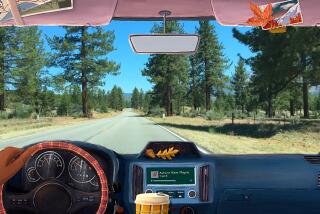On a Road Trip, the Traffic Is Just Part of the Scenery
- Share via
On a recent Thursday, I was forced by the complicated circumstances of my ordinary L.A. life to drive from Glendale to downtown, thence to Beverly Hills and back home to Glendale, a combined distance of about 50 miles that required a total of about two hours. This figure I considered extreme, exhausting and a perfectly good excuse for hurling myself onto the sofa and staying there for as long as my 18-month-old would allow (which wasn’t very long).
Two days later, I piled the child and husband into the same car and drove 150 miles southeast to the small-and-charming town of Julian and back again, a trip that required about five in-car hours, at least half of them on freeways.
This we did willingly and with foresight, and we were not alone: Julian and its byways were chockablock with Angelenos (who gave themselves away by parking in spaces reserved for the horse-drawn carriages and passing at 65 on two-lane roads). The same Angelenos who, surveyed time and time again, list traffic headaches as the No. 1 problem with their city.
Whether under the guise of the Sunday family drive or the collegiate road trip, vehicular jaunts have been an all-American leisure activity since that first Sunday buggy ride. Still, Angelenos average 2 1/2 hours in the car every day. And yet, according to surveys done for Westways magazine, the average Southern Californian takes about four short weekend trips in the car every year.
“It’s leftover DNA from the settlers,” says Richard Davis, a writer living in Glendale who has been known to drive from Chicago to Boulder, Colo., on a whim. “It’s the old cowboy in me. . . . If you have a good horse, you can go places. And you have to go places if you’re going to change the way you look at things.”
The scenery is not the only thing that changes on a road trip. One’s interior landscape rolls by as well. The hum of the engine, the pulse and sway of the road create a womb-like state from which memories emerge, evolve into stories, and parts of ourselves hidden in forgetfulness are suddenly at hand, like lost pieces of a puzzle.
On a road trip, we are beyond the boundaries of work and home maintenance, of information onslaught and consumption temptations. In a moving car, we are pared to essentials.
On the road, we are characters out of our national imagination: Lewis and Clark, Laura Ingalls Wilder, Jack Kerouac, Thelma and Louise, adventurers, doing that which is not ordinary to us. We might be heroes, or highwaymen.
When the trip is for pleasure, every new thing is of interest--the names of rivers, the storefronts on main streets, the cars that pass by. So why then are two hours spent driving through the heart of L.A., a city that is nothing if not visually stimulating, such an annoying, bone-wearying chore?
Maybe it’s all a problem of linguistics. Maybe instead of “commuting,” we should call it all road-tripping.
*
Mary McNamara can be reached by e-mail at [email protected].
More to Read
Sign up for The Wild
We’ll help you find the best places to hike, bike and run, as well as the perfect silent spots for meditation and yoga.
You may occasionally receive promotional content from the Los Angeles Times.







